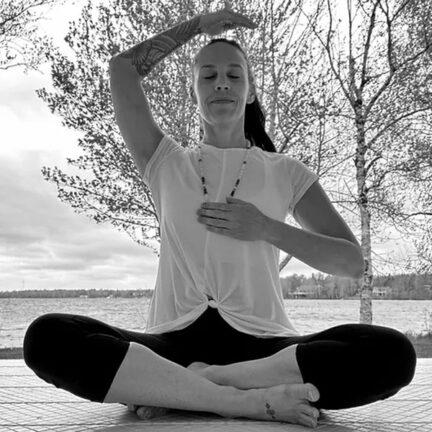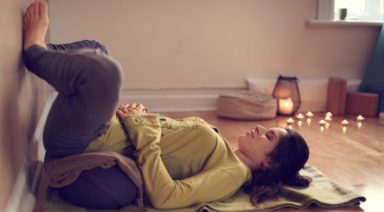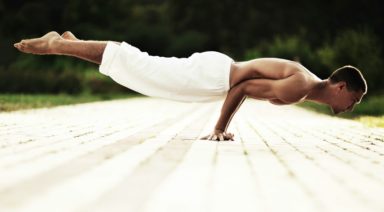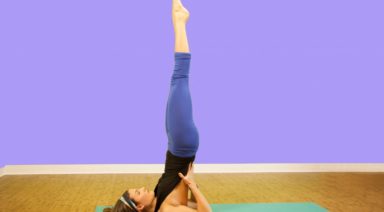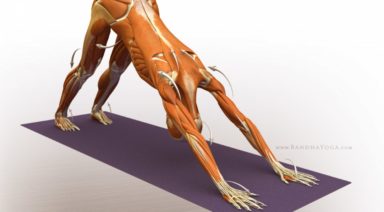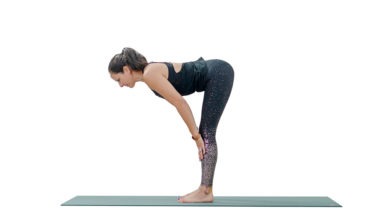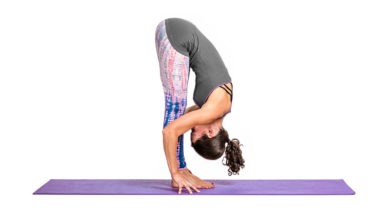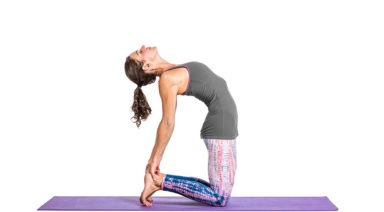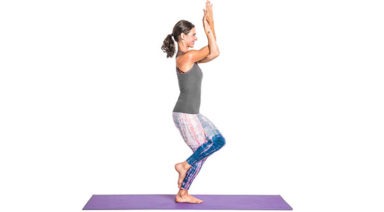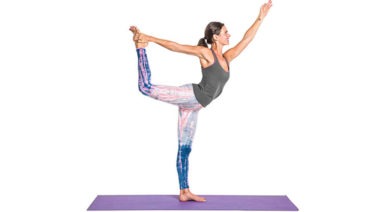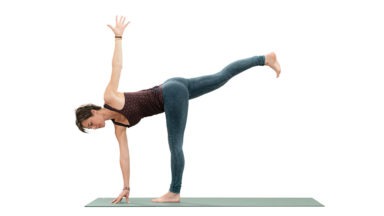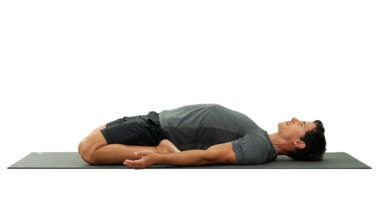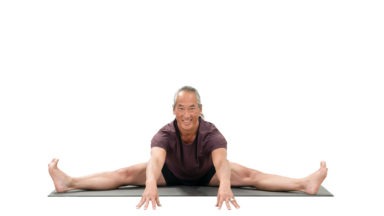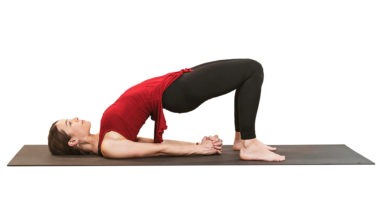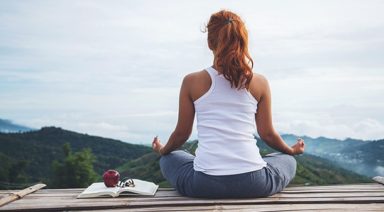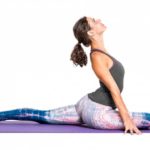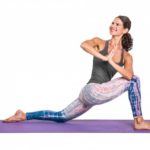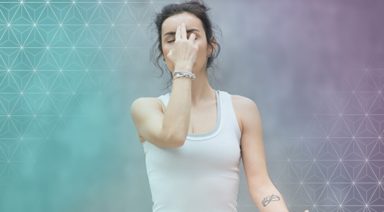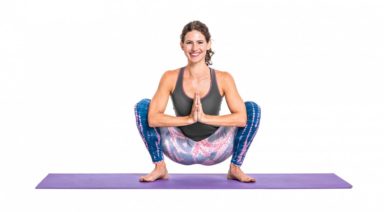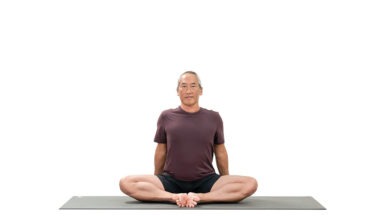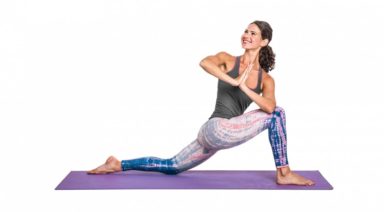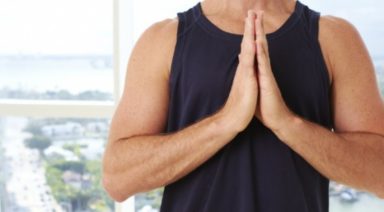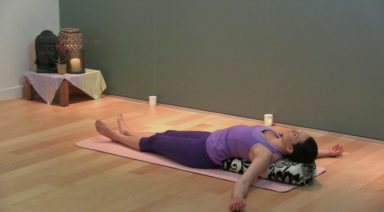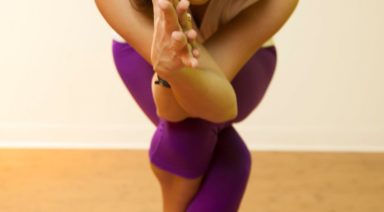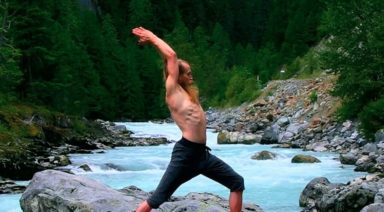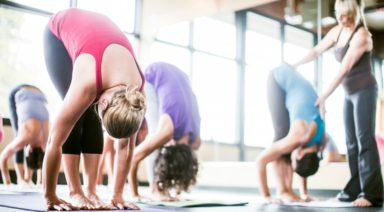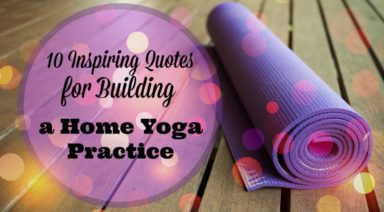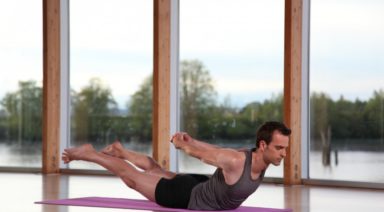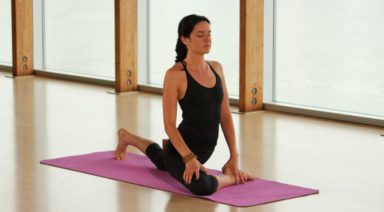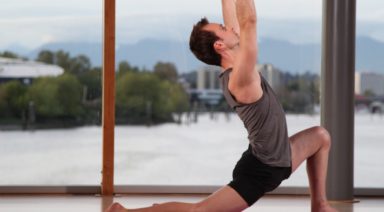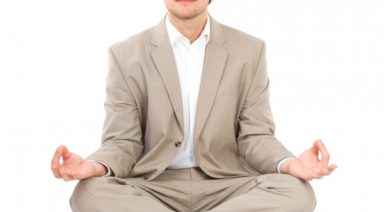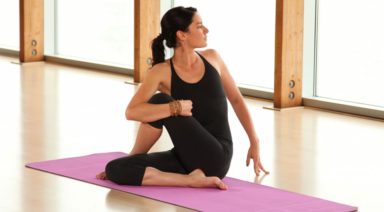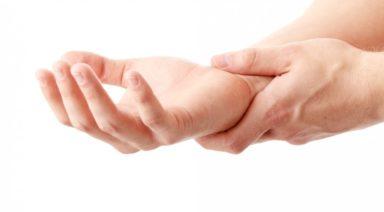5 Yoga Poses to Boost Your OM-munity
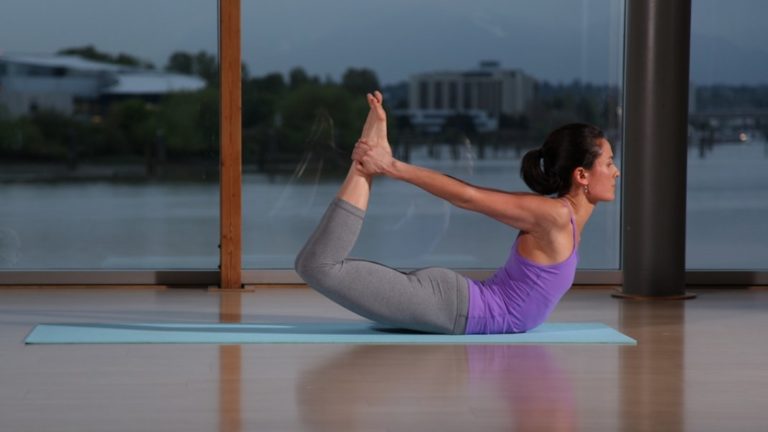
Have you ever noticed that a day after you start your vacation you get sick? Or perhaps a sniffle or cough comes on right before your important work presentation? Or maybe you get taken out by a sore throat or ear ache when you have the most on your plate?
Sadly, bacteria and viruses don’t work around our schedule and can take up residence in your body whether you invite them in or not. The immune system has important job to do each and every day, and if we are sleep deprived, eating on the run, overwhelmed and stressed out, and not taking good care of our body, mind, and emotions, it has a profound effect on its ability to ward off dis-ease.
The health of a women’s immune system depends on the health of all our systems. For almost every health condition a woman faces, we can often trace it back to hormonal imbalances. Colds and flu included, since one of our many systems responsible for a strong immune system is the endocrine system, which includes your ovaries, pituitary, adrenals, thyroid, and hypothalamus. All these organs/ glands are also directly responsible for your monthly menstrual (moon) cycle and regulating hormones.
The nervous, digestive, and circulatory systems also work along with your endocrine system to boost your immune system’s response to invaders. However, if we are experiencing stress and overwhelm, for example, these system functions are jeopardized. This in turn influences your hormones causing you to become susceptible to sickness.
In addition, your emotional state affects your physical health so if you are feeling healthy and vibrant, mostly likely your immune system does too and the team of trillions on white blood cells will attack unwelcome invaders with no fear. Except that throughout a woman’s monthly cycle our emotions can be a roller coaster ride ultimately impacting our ability to stay healthy and virus free.
Our yoga asana practice is a refuge where we can go and take time to nourish and replenish all our systems so that they can function optimally. Yoga asana can help improve our circulation, support our central nervous system, clear the mind, balance emotions, and uplift the spirit. Each of these individual benefits will, collectively, assist in harmonizing the endocrine system and stabilize hormones.
In addition, we want to be sure that we get adequate sleep, 8-9 hours a night, eat foods high in vitamin C and A which stimulate our immunity, and surround ourselves with joy and laughter. Laughter also helps fuel and boost immunity and encourages a positive outlook which helps too!
1. Downward Dog (Adho Mukha Svanasana)
Helps to increase upper body circulation, bring fresh blood to the brain, energizes the legs, and is soothing and calming for intense emotions especially when done with a block or bolster under the head. Calm and rejuvenate!
2. Bow Pose (Dhanurasana)
Puts pressure on the belly which increase blood flow to the abdominal organs which is full of the white blood cells that help us fight invaders. Bow also activates the thymus in the chest that is the primary immune system organ. Invigorate and enliven!
3. Child’s pose (Balasana)
Is calming for the central nervous system and allows the adrenals to relax by receiving the ‘sign’ that there is no distress from your long, deep breaths. Then the immune and digestive systems can return to a balanced state and circulate freely to look for those pesky ‘invaders’. This pose can also be great right before bed to assist in a better nights sleep. Restore and relax!
4. Simple Seated Twist (Bharadvajasana)
Stimulates the spleen, kidneys, liver, and circulation to the belly and reproductive organs which produce immune cells. It also stimulates the flow of lymph fluid through the nodes in groin and the armpits. Replenish and renew!
5. Shoulderstand (Sarvangasana)
Helps bring oxygenated blood to your thyroid and parathyroid glands, supports the lymphatic system in passive circulation, calms the mind and emotions, and soothes nerves if you feel stressed or overwhelmed. Moving in to Plow pose will also help to balance your entire endocrine system which in turn will balance your hormones and emotions.
I also suggest practicing according to your monthly cycle and changing what you practice when in accordance to where you are in your personal cycle. This will make these asanas even more potent and powerful keeping you healthy and balanced all year long. Read my article, Manage Your Mood: Balance Your Cycle With Your Practice to learn how to practice according to your monthly cycle.
Yin Yoga Poses

This article is an exploration of 10 Yin yoga poses. Yin is a style that is practiced by holding poses for a long time in a relaxed state. Yin stands in contrast to other contemporary styles of yoga, such as Vinyasa or Hatha, which generally move the practitioner from pose to pose quickly. Yin yoga ‘asana’, the Sanskrit word for poses, are practiced by following the three principles that Bernie Clark explains in Yin Yoga with Bernie Clark.
Three Principles of Yin Yoga
- Principal 1: Play with your edge
- Principal 2: Stillness
- Principal 3: Hold for Time
Play With Your Edge
Yin is a lunar practice, which tends to be healing and cooling. Unlike solar practices such as sun salutations, yin does not call for heating postures, breathing styles, or sequencing. Therefore the muscles are typically not warm throughout a Yin practice. Entering into poses with cool muscles requires special attention to the first edge.
The first edge is found by gently getting into the shape of a pose and noticing where the body naturally wants to stop. Yielding the natural limitations of the body prevents injury. There should be no pain at the first or any other edge, yet there may be some discomfort. Discomfort without radiating pain is a sign that the connective tissue around the joints is stretching. Reasonable discomfort is a gateway to more flexibility and greater range of motion. Props can add additional comfort and accessibility to yin yoga poses.
You may experience strong physical sensations during a Yin practice such as heat or discomfort. Finding the first edge is a method of exploring the strong sensations and sitting with them. When yoga asana is briefly mentioned in the Yoga Sutras of Patanjali, they are prescribed to be Sthira sukham asanam, or done with steadiness and ease. Steadiness points to the second principal, stillness, which is explored later in the article.
About 30-60 seconds into a pose, or if and when the body shows signs of being able to go deeper, it is safe to move to the second edge (or third or forth). It is important that the body, not the ego, give the signal to deepen. This humble practice never asks the yogi to prove or force anything. There is no need to try to “achieve” or to look a certain way. Gentleness, acceptance and honesty are critical in a yin practice. If the body starts to tighten, it’s a sign to slowly come out of the pose.
Stillness
Classical yoga was practiced as a means to still the mind for meditation. Sitting still in yin yoga poses lets the contemporary yogi dip their toes into the waters of deep meditation. One exception to stillness is when the body opens to a new edge. With the awareness that the body is ready to deepen, Yin yogis consciously move deeper and return again to stillness and breath. Another exception to stillness is the awareness of pain. In response to pain, it’s time to come out of the pose slowly.
Hold for Time
The third principal is to hold the poses for time. Poses can last anywhere from one minute to longer than 15 and in general are done for 5-10 minutes. Using a timer tells you how long you are staying still, which can be a way to gauge stillness from practice to practice. A timer can also ensure that both sides of the body get the same amount of time, which results in feeling delightfully balanced. The breath can continue to deepen the longer a pose is held. The lungs can expand seemingly forever. Counting breath is an interesting way to observe the expansive nature of the breath, which becomes possible during long holds. Profound experiences become accessible only when conscious and deepening pranayama is practiced.
Breathing expansively while remaining still presents the practitioner with what is rarely otherwise observed: the quiet inner dance of consciousness, an inner world so rich and mysterious, it is invisible most of the time. Holding (still) for time never seemed so tempting.
What Do You Need to Practice Yin Yoga?
- Yoga mat or as an alternative, a thick blanket or carpet.
- Yoga blankets and bolsters or as an alternative, towels and pillows nearby
- Blocks or (or books if you have none)
Optional items
- Sand timer
- Soft music
- Candles
10 Yin Yoga Poses
1. Chest and Shoulder Expansion
Sit cross-legged, your right side adjacent to the wall, reach your right hand back so the palm is flat against the wall at about shoulder height. Scoot your right hip in closer to the wall if you feel you can safely tolerate more stretch. Once the shoulder feels settled, bend the arm so you have the palm directly above the elbow at the height of your gaze. Sit and breathe for several moments. If you feel you can safely deepen, allow the left hand to come beside and slightly behind your left hip and press fingertips into the floor. Lift and open your chest. Slowly drop the left shoulder down and perhaps the chin and gaze point follow. Stay for 1-5 minutes breathing gently.
2. Lower Back Pose
Sit on a cushion if you have tight hamstrings or flat on the mat for more open hamstrings. Let the legs extend and relax so that the feet flop out gently to their respective sides. Knees can be slightly bent. Pressing the fingertips downward into the ground beside the hips, lengthen the heart higher in contrast. Then tuck the chin into the chest. Let the upturned palms fall to the outside of the thighs near the knees. Allow the upper spine to round. For your second edge, the hands may move down the legs closer to the ankles. Remember not to strive or do too much. Stay and breathe 1-5 minutes.
3. West-Facing Pose
This pose just like the lower back pose, sitting up legs relaxed and extended. Place one bolster over your thighs. Lift though the chest as you inhale and as you exhale fold forward and down, hinging from the hips so as to keep length in the low back. If you are not able to lay upon the cushion, add more props until you can easily lay your chest and face on them. Find your first edge. At this time you may determine to remove or reduce the props so that you can go deeper. Stay in the pose for 1-5 minutes. Note, this pose is called “west-facing” because it is cooling, like the setting sun, which sets in the west.
4. Wide Leg Child Pose
On your mat, add cushion beneath the knees using a blanket or towel. Bring the knees as wide or wider than the mat and big toes to touch or towards one another. Press your hips back toward the heels and walk your hands forward as you fold from the hips. Imagine a gentle anchor keeps the hips downward and the low back spreading wide. From there, stretch the arms, chest and head forward and down. If the head cannot touch the floor, put a block or folded blanket beneath it so it can rest. You may prefer to rest upon the forehead or to turn the head to one side and then the other. Let your arms and hands relax into the floor. Notice your edge and deepen if and when it feels right. Come out if the knees start to bother you, moving slowly. Practice for 1-5 minutes.
5. Wide Leg Child Pose, Thread the Needle Variation
From wide leg child pose, slightly raise the head and walk the right hand back. Thread the right hand under the left until the right shoulder is on the ground and put the right temple on the floor. Repeat on the left side. Practice 1-5 minutes on each side.
6. Lizard
Come to your hands and knees with a folded blanket under the knees for padding. Bring your right foot forward so it is just to the right on the right hand, make sure your shoulders are over the wrists. The right knee stacks over the right ankle so your shin may feel as though it is moving forward in space. If the right knee pops out to the right, redirect it over the ankle, pressing down into the right foot and imagine pressing the shin forward.
If needed, bring your hands up on blocks, lift through the chest, curl the left toes under and squeeze the left leg so the thigh lifts off the ground. This will cause the thigh to rotate internally, which means the alignment is now safe for deepening. Now , bringing the left knee down onto the blanket and then flatten the top of left foot into the mat. You may stay like that or bring your elbows onto the blocks to deepen. You may end up with no blocks, elbows on the mat beneath the shoulders or you may end up staying high on blocks. Honor where the body needs to go and remain for 1-5 minutes before repeating on the other side.
7. Pigeon
Place a flat bolster horizontally across the mat or a folded blanket about halfway down the length of the mat. Place both knees on the bolster. Bring the right knee forward of the cushion in front of the right hip and the foot toward on left side of the mat. Place the palms on blocks beneath the shoulders and bring the left leg back so that the thigh and top of left foot are pressing into or towards the floor. Let the pelvis be supported by the cushion. You may stay upright, opening the chest, or choose to ease yourself down, perhaps deepening to the point where your head rests on blocks or on the floor. Remain in the pose 1-5 minutes and repeat on the other side.
8. Supported Reclined Butterfly
The use of props to recline makes this supportive and relaxing. To do so, place a block the tall way and another the short way so they make an L. Lay a bolster or supportive cushion over the blocks so that it a slanted toward the floor. Place yourself with your back against the lower part of the cushion with the souls of your feet touching. To keep the feet together and to allow the hips to relax, use a strap or a long rolled blanket to wrap the feet.
9. Supported Gentle Fish
Place a block at medium height near the top of the mat. Sit so the block is behind you with the legs extended and relaxed. Lay your back over the blocks so they land between your shoulder blades boosted your heart up. Let your head relax back onto a block, making sure the neck is supported. Allow the arms to pour open and drip into the floor on either side. Breathe into the heart and let the body seep down onto the props. As your edge moves, notice the chest may boost higher. Remain 1-5 minutes.
10. Corpse Pose/ Savasana
Lay on the mat on your back. Let the arms and legs relax. Arms by your sides, feet slightly flop out. If your lower back is uncomfortable place blocks or a cushion under the knees. Stay as long as you wish. Let go of doing and drop into being.
Photos courtesy of author Lara Hocheiser and featuring Blair Smalls.

